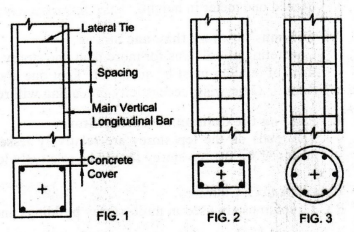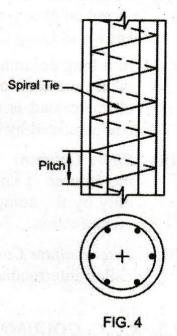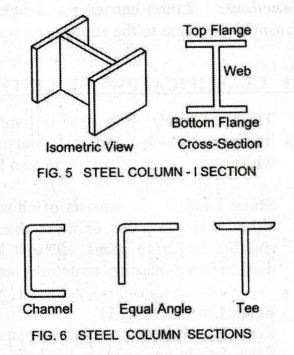Basic Civil & Mechanical Engineering: UNIT III: f. Beams, columns and lintels
Columns
Definitions, Types, RCC, Steel Columns, Stanchions
Column is a vertical structural member. It transmits the load from ceiling/roof slab and beam, including its self-weight to the foundation.
COLUMNS
Column
is a vertical structural member. It transmits the load from ceiling/roof slab
and beam, including its self-weight to the foundation. Columns may be subjected
to a pure compressive load or a combination of compressive load and bending
moment. Columns may be constructed of Stone or Brick Masonry, Timber,
Reinforced Cement Concrete (R.C.C.) or Structural Steel Sections. R.C.C.
columns are the most widely used now-a-days.
1. DEFINITIONS
Effective
Length: Effective length of a column is not necessarily its
Actual or True Length. It depends upon the conditions of end supports of the
column.
Column
Failure: It depends on the Effective Length of the column
compared to its cross-section.
Types
of Columns: Based on the Effective Length, columns
are classified as follows:
(i)
Long Column or Slender:. If the ratio of the effective
length to the least lateral dimension of the column (or diameter of the column
of circular cross-section) is > 12, the column is known as Long Column or
Slender. Slender means narrow in width.
In
a long column, the ultimate load is governed by the compressing and bending
strengths of the material of the column and the dimensions of the cross
section. In addition, the ultimate load is also influenced by slenderness.
Thus, for long columns, failure load is characterized by buckling or
instability.
(ii)
Short Column: If the ratio of the effective length to
the least lateral dimension is < 12, the column is known as Short Column. In
a short column, the ultimate load is governed only by the compressive strength
of the material of the column and the dimensions of the cross section. For
short columns, the failure load is characterized by yielding.
(iii)
Intermediate Column: Column with length that is between the
short and long columns is called Intermediate Column. Intermediate columns fail
by both yielding and buckling.
2. R.C.C. COLUMNS
If
the effective length of a compression member is equal to or less than thrice
the least lateral dimension, the member is made of Plain Cement Concrete. If
the effective length is more than thrice the least lateral dimension, the
member should be of R.C.C.
1.
Columns of Square, Rectangular and Circular Sections
See
Fig. 1 (Square), Fig. 2 (Rectangular) and Fig. 3 (Circular).

R.C.C.
columns are reinforced with Vertical Longitudinal Steel Bars (Vertical Main
Reinforcement Steel Bars) tied by Lateral Steel Bars, which act as Lateral
Ties. Lateral ties are also known as Stirrups.
Stirrups:
Stirrups are tying the main bars so that the main bars should not buckle outward
under load. Thus, lateral ties provide lateral rigidity to the column. Also,
these ties keep the main bar in position without getting dislocated during
concreting and compaction.
In
the R.C.C. columns, longitudinal bars take the main load. Stirrups prevent the
buckling of longitudinal bars and keep them in position with respect to each
other.
Load
Carrying Capacity of R.C.C. Column: If the percentage of
steel used is large in a column, the concrete fails first.
If
the percentage of steel used is less, the steel will reach its yield strength
prior to concrete. The column will not fail, because it can take more loads at
this stage. Thus, the strength of the column is fully utilized.
2.
Spirally Reinforced Column (Fig. 4)

Sometimes,
for circular column, the lateral ties are made in the form of a continuous
Spiral. It is called Spirally Reinforced Column.
Pitch:
Pitch should not be more than 1/6 diameter of the column.
3.
Precautions to be observed in Column Construction
1.
Process of Construction
Construction
of concrete columns (i.e., concreting, compacting and curing) is similar to the
construction of any R.C.C. works such as beams, etc.
2.
Vertical Height of Concrete
Vertical
height of concrete placed in one layer should not exceed one meter in height.
3.
Columns for more than one Storey
Concreting
of columns for more than one storey is to be carried out very accurately.
Central lines of column must be accurately kept one above the other for columns
placed in different floors. Otherwise, eccentricity in loading will result.
4.
Load on the Column of the Top Storey
The
loads on the top storey are relatively lesser. Hence, the cross section of the
colum designed for the top storey should be relatively less.
Uses
of R.C.C. Columns
R.C.C.
columns are used in multi-storey buildings and heavily loaded structures.
3. STEEL COLUMNS or STANCHIONS
Steel
Columns are also known as Stanchions. These are used in industrial structures
to support the Beams and Trusses.
Steel
Column is a vertical compression member. It supports the Floors or Girders in a
building. Girder is a main load carrying member into which floor beams or
joists are connected. Joists are beam members, which are used to carry floors
and roofs of buildings of light loads supported on long columns.
Standard
Structural Steel Sections
Structural
steel is factory made in several forms called Rolled Steel Sections. See Figs.
5 and 6. Standard steel sections, namely, I-Section, Channel Section, Equal
Angle Section, Tee Section, Z Section, Round Section and Tubular Section are
used for light loads.

The
shape of the cross section of the steel section and the sectional area should
be designed carefully to avoid buckling.
The
important property required for a compression member is a high value of Moment
of Inertia. [Moment of Inertia of a body about any axis refers to the internal
resistance of the body to rotation about that axis.]
1.
Built-up Column Sections (Fig. 7)
When
the loads on the column are heavy Built-up Column Sections are used.
When
two or three steel sections of rolled sheets and cover plates are connected to
form a column, it is known as a Built-up Column or Box Column. Cover Plates (or
Additional Plates) are properly welded with the main sections.
Fig.
7 shows different types of built-up sections for steel columns. The type of
built-up ection to be used depends on the type of structure and the end
connections of the column.
Uses:
Built-up sections are used in steel skeleton constructions, roof trusses, etc.

Basic Civil & Mechanical Engineering: UNIT III: f. Beams, columns and lintels : Tag: : Definitions, Types, RCC, Steel Columns, Stanchions - Columns
Related Topics
Related Subjects
Basic Civil and Mechanical Engineering
BE3255 2nd Semester 2021 Regulation | 2nd Semester EEE Dept 2021 Regulation
